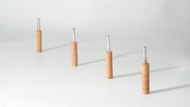How to Select Your Oboe Staple
Posted by Ann Hodge on Mar 14th 2022
Demystifying Oboe Reed Staples in 36 Models
Chapters
- How to Select Your Oboe Staple
- Introduction
- Chapter 1
- 4 Effects Staples Have on Your Oboe Reeds
- Chapter 2
- 10 Characteristics of Oboe Staples
- Chapter 3
- 15 Oboe Staple Brands
- Chapter 4
- Oboe Mandrels
- Conclusion
- Oboe Staple Selection Tool
Is the wrong oboe staple negatively affecting your playing experience?
The little understood oboe staple is critical to aspects of tone, intonation, response and pitch. Understanding the complexities of oboe staples, and choosing the best one for you, can drastically improve your experience and help you achieve your musical goals.
Why are there so many varieties of staples?
Does the staple make the difference in pitch, or tone, or how open the reed is?
Are there certain staples that “go with” certain oboes or reed styles?
How do I choose which one is right for me and my setup?
In this comprehensive guide, you'll find the basic principles of staple design, and learn how to take advantage of the unique characteristics of each staple to achieve the results you want in your music. Read on to understand which staples are the best ones to try for your setup.
Or, if you already understand how staples affect reeds and just want to look at individual staple characteristics, click on a link below to find out about a specific staple brand.
So, what do oboe staples affect?
The dimensions of the staple are critical to the characteristics of the reed and to bringing out the best qualities in the oboe. It is crucial to find the best match between oboe, staple, and cane shape to establish precise intonation and a beautiful tone.
There are so many variables in this process that it is often a lifetime pursuit.
Our research takes the guesswork out of choosing which staples to experiment with to affect specific aspects of tone, intonation, response, and pitch.
- Measuring Tool:We used an Electronic Digital Caliper to the 100th millimeter with inside and outside measuring tines to measure all the parts of the staples.
- Staple Base: We measured the diameter of the inside at 1mm in, and after averaging the results, calculated the actual base measurement based on angle measurements from uncorked staples.
- Staple Tip: We measured the diameter of the long section of the ellipse, then measured the diameter of the short section of the ellipse. Unlike the staple base, where it is difficult to measure the precise edge diameter of the staple, the staple tip is angled inward and therefore is the smallest part of the staple, making it easy to measure. (The caliper tines are a mere 10th of a millimeter in width at the edge so there is a negligible amount of loss on the curve.)
- Staple Length: We measured the tip to base length on 50 staples, then averaged them.
- Wall Thickness: We measured the tip wall thickness on each of the long sides of the ellipse and averaged them. Base wall thickness was determined by measuring ten places around the circumference of the uncorked staple and averaging it.
- Taper Angle: The cork was removed, and the staple was carefully placed for high resolution, front-view and side-view pictures. The angle changes of the staple images were measured digitally.
- Volume: This was determined using water and a tiny digital scientific scale accurate to 1 milligram. Ten staples of each model were filled with water and then the water was weighed. An average was taken for each model.
The information in this article is heavily influenced by the work of Graham Salter, author of Understanding the Oboe Reed. We recognize and appreciate the precise and detailed information he provides throughout his book.
As Graham Salter says in Understanding the Oboe Reed,
The right combination of bore, length and metal to suit the particular oboe will release startling tonal depth and sparkle, to emulate a vast boost in the quality of the cane. (Salter, p. 445)
In Chapter 1, we discuss the four main effects staples have on your oboe reeds. Click on the button below to go to Chapter 1 to read about them.

